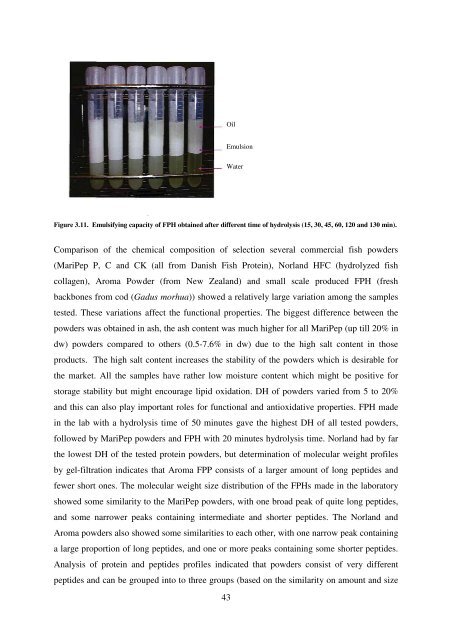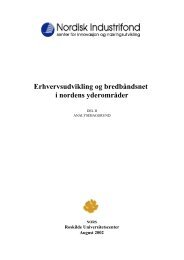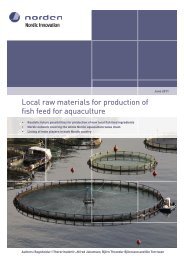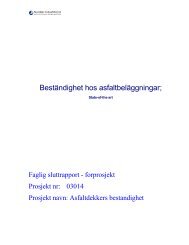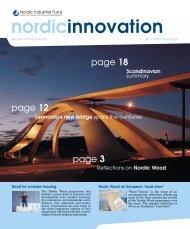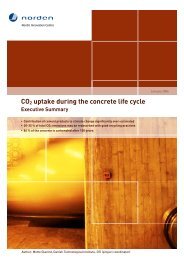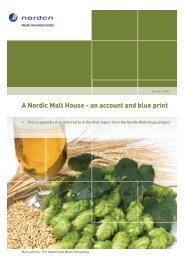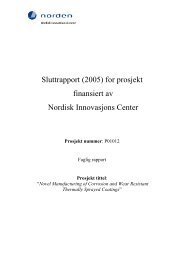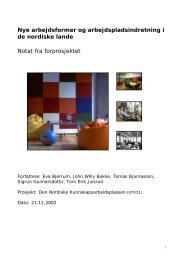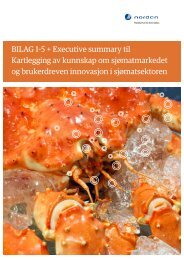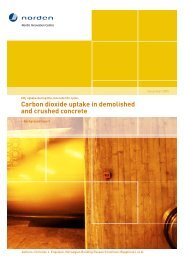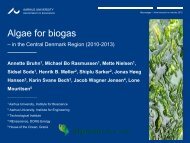Value added fish by-products - Nordic Innovation
Value added fish by-products - Nordic Innovation
Value added fish by-products - Nordic Innovation
You also want an ePaper? Increase the reach of your titles
YUMPU automatically turns print PDFs into web optimized ePapers that Google loves.
Figure 3.11. Emulsifying capacity of FPH obtained after different time of hydrolysis (15, 30, 45, 60, 120 and 130 min).<br />
Comparison of the chemical composition of selection several commercial <strong>fish</strong> powders<br />
(MariPep P, C and CK (all from Danish Fish Protein), Norland HFC (hydrolyzed <strong>fish</strong><br />
collagen), Aroma Powder (from New Zealand) and small scale produced FPH (fresh<br />
backbones from cod (Gadus morhua)) showed a relatively large variation among the samples<br />
tested. These variations affect the functional properties. The biggest difference between the<br />
powders was obtained in ash, the ash content was much higher for all MariPep (up till 20% in<br />
dw) powders compared to others (0.5-7.6% in dw) due to the high salt content in those<br />
<strong>products</strong>. The high salt content increases the stability of the powders which is desirable for<br />
the market. All the samples have rather low moisture content which might be positive for<br />
storage stability but might encourage lipid oxidation. DH of powders varied from 5 to 20%<br />
and this can also play important roles for functional and antioxidative properties. FPH made<br />
in the lab with a hydrolysis time of 50 minutes gave the highest DH of all tested powders,<br />
followed <strong>by</strong> MariPep powders and FPH with 20 minutes hydrolysis time. Norland had <strong>by</strong> far<br />
the lowest DH of the tested protein powders, but determination of molecular weight profiles<br />
<strong>by</strong> gel-filtration indicates that Aroma FPP consists of a larger amount of long peptides and<br />
fewer short ones. The molecular weight size distribution of the FPHs made in the laboratory<br />
showed some similarity to the MariPep powders, with one broad peak of quite long peptides,<br />
and some narrower peaks containing intermediate and shorter peptides. The Norland and<br />
Aroma powders also showed some similarities to each other, with one narrow peak containing<br />
a large proportion of long peptides, and one or more peaks containing some shorter peptides.<br />
Analysis of protein and peptides profiles indicated that powders consist of very different<br />
peptides and can be grouped into to three groups (based on the similarity on amount and size<br />
Oil<br />
43<br />
Emulsion<br />
Water


